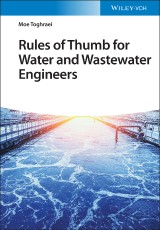Details

Rules of Thumb for Water and Wastewater Engineers
1. Aufl.
|
115,99 € |
|
| Verlag: | Wiley-VCH |
| Format: | EPUB |
| Veröffentl.: | 30.03.2022 |
| ISBN/EAN: | 9783527831135 |
| Sprache: | englisch |
| Anzahl Seiten: | 368 |
DRM-geschütztes eBook, Sie benötigen z.B. Adobe Digital Editions und eine Adobe ID zum Lesen.
Beschreibungen
<b>Rules of Thumb for Water and Wastewater Engineers</b> <p><b>A unique resource that helps water engineers make quick evaluations and estimate design decisions</B> <p>Water and wastewater treatment are essential processes in the water economy and as such, vital to the health and success of any community. At its core, the essence of this process is converting one analysis (source water, which can come from wells, lakes, sea, wastewater or even treated wastewater) into goal water. The process is generally separated by industrial and municipal processes according to intention of the produced water. <p>Relying on a contaminant-classified approach, <i>Rules of Thumb for Water and Wastewater Engineers</i> provides engineers with the necessary skills to ascertain the best methodology for a broad range of impurities in an H2O source. Within these bounds, the manual offers guidelines for important areas of management: potable water treatment, municipal wastewater treatment, industrial water treatment, and industrial wastewater treatment. As the first step to water treatment is to identify both consumers and contaminants, this program gives engineers a resource to easily reference the appropriate chapter for a given contaminant, and thereby evaluate situations quickly and estimate design decisions at a glance before a more detailed approach is taken. <p><i>Rules of Thumb for Water and Wastewater Engineers</i> readers will also find: <ul><li>Tools that provide quick way to evaluate a situation and make quick decisions</li> <li>Two chapters on removing dissolved materials, a complex topic that deserves much attention</li> <li>Rules of thumb developed over the course of over 20 years of experience by the author</li> <li>Illustrations and figures to help elucidate points made throughout the text</li></ul> <p><i>Rules of Thumb for Water and Wastewater Engineers</i> is a useful reference for environmental engineers, chemical engineers, municipal engineers, chemists, and industries including the paper and food industry.
Part 1 -<br> General<br> 1.1 Water Resources - surface vs ground<br> 1.2 Water Consumers<br> Part 2 -<br> Water Contaminants<br> 2.1 Settleables<br> 2.1.1 (Dead) Particles<br> 2.1.2 (Live) Organisms<br> 2.2 Floatables<br> 2.3 Dissolved<br> 2.3.1 Dissolved Gases<br> 2.3.2 Dissolved Ions<br> 2.3.2.1 Specific Ions<br> 2.3.2.1.1 Total hardness of Water<br> 2.3.2.1.2 Alkalinity of Water<br> 2.3.2.1.3 pH of Water<br> 2.3.2.2 Total Dissolved Solids of Water<br> 2.4 Colloids<br> 2.5 Contaminants in different forms<br> 2.6 Water Analysis<br> 2.7 Water Temperature<br> Part 3 -<br> Removal Methods<br> 3.1 Settleable removal<br> 3.1.1 Sedimentation<br> 3.1.1.1 Universal g-force Sedimentation<br> 3.1.1 Enhanced g-force Sedimentation (Cyclonic separation, Centrifugation)<br> 3.1.2 Filtration<br> 3.1.2.1 Conventional Filtration<br> 3.1.2.2 Membrane Filtration<br> 3.2 Floatable removal<br> 3.2.1 Creaming<br> 3.2.1.1 Universal g-force Creaming<br> 3.2.1.2 Enhanced g-force Creaming (Cyclonic separation, Centrifugation)<br> 3.2.1.3 Gas assisted Creaming (dissolved gas, dispersed gas flotation)<br> 3.2.2 Filtration<br> 3.2.2.1 Conventional Filtration<br> 3.2.2.2 Membrane Filtration<br> 3.2.3 Adsorption<br> 3.3 Dissolved material removal<br> 3.3.1 Dissolved Organic removal<br> 3.3.1.1 Biological Treatment<br> 3.3.1.2 Non-Biological Treatments (Adsorption, Ion exchange, Incineration)<br> 3.3.1.3 Advanced Oxidation Treatment<br> 3.3.2 Dissolved inorganic removal<br> 3.3.2.1 Total Dissolved inorganic removal<br> 3.3.2.1.1 Ion Exchange<br> 3.3.2.1.2 Reverse Osmosis<br> 3.3.2.1.3 Evaporation<br> 3.3.2.2 Specific Ion removal<br> 3.3.2.2.1 Precipitation<br> 3.3.2.2.2 Selective Ion Exchange<br> 3.3.3 Dissolved Gas removal<br> 3.3.1.1 Stripping<br> 3.3.1.1 Removing by considering as dissolved organics or inorganics<br> 3.4 Colloid Removal<br> 3.4.1 Direct Colloid Removal<br> 3.4.2 Colloid Removal by converting to solid<br> 3.5 Dealing with live organisms<br> Part 4 ? Process Development<br> 4.1 Water management<br> 4.2 Equalization<br> 4.3 Treatment strategy<br> 4.4 Pre-and Post- treatment
<p><b><i>Moe Toghraei, BSc, MSc, P.Eng, </b>is an instructor and consultant with Engrowth Training based in Calgary, Alberta, Canada. He has more than 20 years of experience in the chemical process industries. He holds a B.Sc. in Chemical engineering from Isfahan University of Technology, Iran and an M.Sc. in Environmental Engineering from Tehran University, Iran. He is a Professional Engineer in the province of Alberta, Canada.</i></p>
<p><b>A unique resource that helps water engineers make quick evaluations and estimate design decisions</B></p> <p>Water and wastewater treatment are essential processes in the water economy and as such, vital to the health and success of any community. At its core, the essence of this process is converting one analysis (source water, which can come from wells, lakes, sea, wastewater or even treated wastewater) into goal water. The process is generally separated by industrial and municipal processes according to intention of the produced water. <p>Relying on a contaminant-classified approach, <i>Rules of Thumb for Water and Wastewater Engineers</i> provides engineers with the necessary skills to ascertain the best methodology for a broad range of impurities in an H2O source. Within these bounds, the manual offers guidelines for important areas of management: potable water treatment, municipal wastewater treatment, industrial water treatment, and industrial wastewater treatment. As the first step to water treatment is to identify both consumers and contaminants, this program gives engineers a resource to easily reference the appropriate chapter for a given contaminant, and thereby evaluate situations quickly and estimate design decisions at a glance before a more detailed approach is taken. <p><i>Rules of Thumb for Water and Wastewater Engineers</i> readers will also find: <ul><li> Tools that provide quick way to evaluate a situation and make quick decisions</li> <li>Two chapters on removing dissolved materials, a complex topic that deserves much attention</li> <li>Rules of thumb developed over the course of over 20 years of experience by the author</li> <li> Illustrations and figures to help elucidate points made throughout the text</li></ul> <p><i>Rules of Thumb for Water and Wastewater Engineers</i> is a useful reference for environmental engineers, chemical engineers, municipal engineers, chemists, and industries including the paper and food industry.


















